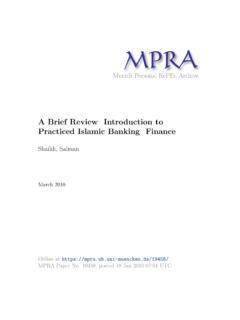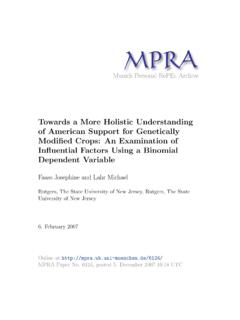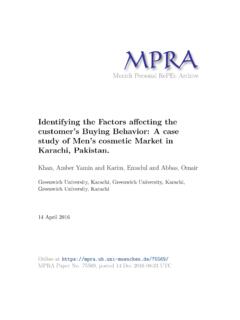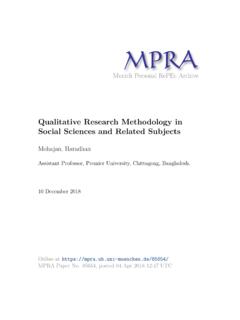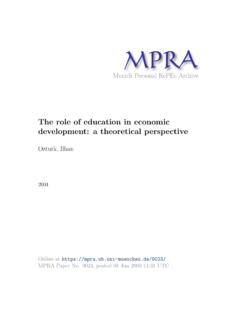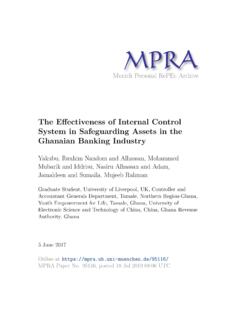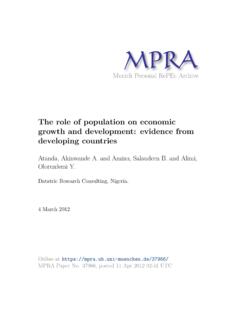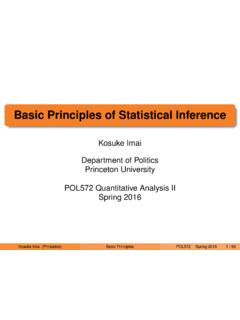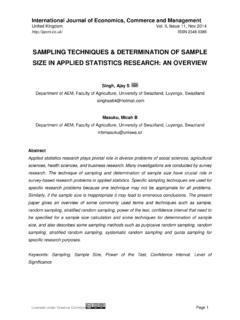Transcription of A Manual for Selecting Sampling Techniques in Research
1 Munich Personal RePEc ArchiveA Manual for Selecting SamplingTechniques in ResearchAlvi, MohsinUniversity of Karachi, Iqra University23 March 2016 Online Paper No. 70218, posted 25 Mar 2016 17:01 UTCM. H. Alvi (2016): A Manual for Selecting Sampling Techniques in Research 1 A Manual for Selecting Sampling Techniques in Research Mohsin Hassan Alvi M. H. Alvi (2016): A Manual for Selecting Sampling Techniques in Research 2 flyleaf - 1 This Page Intentionally Left Blank M. H. Alvi (2016): A Manual for Selecting Sampling Techniques in Research 3 ACKNOWLEDGEMENT Presenting this Manual in front of you, I am very grateful to my Almighty Allah who made the completion of this project possible for me. There are some people on earth too, whom I really need to show my gratitude for their support for this project; who talked things over, read, wrote, offered comments, allowed me to quote their remarks and assisted in the editing, proofreading and design I would like to thank Ms.
2 Midra Ikram, Dr. Imtiaz Subhani, Dr. Shabib, and Dr. Nusrat Hussain who stood beside me throughout my working period and kept on guiding me. I cannot undermine the support of my family and friends who keep on encouraging me and boost up my energies. Last but not the least, I ask for the pardon to those, who efforts are included in the Manual one way or the other and fail to mention their names in it. M. H. Alvi (2016): A Manual for Selecting Sampling Techniques in Research 4 PREFACE The Manual for Sampling Techniques used in Social Sciences is an effort to describe various types of Sampling methodologies that are used in researches of social sciences in an easy and understandable way. Characteristics, benefits, crucial issues/ draw backs, and examples of each Sampling type are provided separately. The Manual begins by describing What is Sampling and its Purposes then it moves forward discussing the two broader types: probability Sampling and non-probability Sampling .
3 Later in the text various types of each of the broader category are discussed. Reading the Manual from beginning to the end you will find some points are repeated under various headings. This is done to make each topic exclusively a complete whole so that there might not remain any requirement to read other topics for understanding the one. Also, similar examples with a little modification are used in the description of different Sampling Techniques . The purpose behind doing this is to clarify the minor distinction in the applicability and usage of different types of Sampling Techniques . I have also included a section comparison of some Resembling Sampling Techniques , the purpose of which is to eliminate confusions among the Techniques that look somewhat similar to each other. Both types of characteristics are described: that make the Techniques resembling, and that create the difference between them.
4 In the section Which Sampling technique to use in your Research , it has been tried to describe what Techniques are most suitable for the various sorts of researches. So one may easily decide which particular technique is applicable and most suitable of his or her Research project. There are three appendices in the Manual which are giving a concise view of all the Techniques discussed in the text. Appendix I is giving a comparison of two broader categories of Sampling methods: probability, and non probability. Appendix II is portraying a brief summary M. H. Alvi (2016): A Manual for Selecting Sampling Techniques in Research 5 of various types of probability Sampling technique . Appendix III is presenting a brief summary of various types of non-probability Sampling technique . A glossary is also provided in the Manual . The words that are used as synonyms to one another are mentioned.
5 Moreover, definitions of the terms that are repetitively used throughout the Manual are provided. The words defined in the glossary are written with italic letters in the text. M. H. Alvi (2016): A Manual for Selecting Sampling Techniques in Research 6 TABLE OF CONTENT POPULATION SAMPLE AND 6 Population and a sample .. 7 Sampling and its purposes .. 9 Types of Sampling .. 10 VARIOUS TYPES OF PROBABILITY Sampling 12 Simple 13 systematic 16 Stratified 19 22 25 VARIOUS TYPES OF NON PROBABILITY Sampling 27 Volunteer 28 Convenient 30 Purposive 32 Quota Sampling (proportional and non proportional).. 33 Snowball 35 Matched 37 Genealogy based 38 comparison OF SOME RESEMBLING Sampling .. 39 comparison of Stratified Sampling with Quota 40 comparison of Stratified Sampling with cluster 40 comparison of Stratified Sampling and cluster Sampling with Multistage Sampling 40 comparison of genealogy based Sampling with chain 41 M.
6 H. Alvi (2016): A Manual for Selecting Sampling Techniques in Research 7 WHICH Sampling technique TO USE IN Research ?.. 42 Which Probability Sampling is appropriate for your Research ?.. 43 Which Non-probability Sampling is appropriate for your Research ?.. 45 46 47 Appendix I: comparison of probability and non-probability Sampling .. 48 Appendix II: Various types of probability Sampling technique in a 50 Appendix III: Various types of non-probability Sampling Techniques in a 53 M. H. Alvi (2016): A Manual for Selecting Sampling Techniques in Research 8 flyleaf - 2 This Page Intentionally Left Blank M. H. Alvi (2016): A Manual for Selecting Sampling Techniques in Research 9 POPULAION, SAMPLE AND Sampling M. H. Alvi (2016): A Manual for Selecting Sampling Techniques in Research 10 POPULATION AND A SAMPLE Population Target population refers to all the members who meet the particular criterion specified for a Research investigation.
7 For example a population of schools of Canada means all the schools built under the boundary of the country. A population of OCD means all the people having clinical diagnosis of the disorder. A single entity of any given population which is not decomposable further is called as an element. An element may be an individual, a household, a factory, a market place, a school, etc. What an element is going to be depends on the nature of population. What a population is going to be depends on the nature of investigation. A population may be homogenous or heterogeneous. A population is said to be homogenous when its every element is similar to each other in all aspects. In other words, every element has all the characteristics that meet the described criteria of target population. A population is said to be heterogeneous when its elements are not similar to each other in all aspects.
8 In other words, one characteristic variable is not same among all the elements while they meet the rest of the criteria that defines the target population. Variables that make a population heterogeneous vary greatly from Research to Research . Common variables that make a population heterogeneous are gender, age, ethnicity, socioeconomic status etc. Moreover, the homogeneity and heterogeneity of population depends on the goal and nature of your Research . Same population may be homogenous for one Research project and heterogeneous for the other. For instance, if the goal of a Research is to investigate average IQ of the employs of XYZ Company. The population is homogenous which is composed of people who work at the M. H. Alvi (2016): A Manual for Selecting Sampling Techniques in Research 11 company. It does not matter for the Research purpose whatever socioeconomic, religious or gender group the workers may belong to.
9 Now consider another Research the purpose of which is to find if the environment of the Company is satisfactory for its employs. In this case, men and women are likely to keep different opinions (as our prior knowledge tells us women encounter issues of harassment, gender indiscrimination etc. at work places). Now the population needs to be divided into two groups: male workers of XYZ Company and female workers of XYZ Company. In this way, the same population that was homogenous for the former Research becomes heterogeneous on gender basis for the later. Sample A sample can be defined as a group of relatively smaller number of people selected from a population for investigation purpose. The members of the sample are called as participants Sampling AND ITS PURPOSE The process through which a sample is extracted from a population is called as Sampling . In investigation it is impossible to assess every single element of a population so a group of people (smaller in number than the population) is selected for the assessment.
10 On the basis of information obtained from the sample, the inferences are drawn for the population. The more the sample is representative of the population, the higher is the accuracy of the inferences and better are the results generalisable. A sample is said to be representative when the characteristics of elements selected are similar to that of entire target population. The results are said to be generalisable when the findings obtained from sample are equally true for the entire target population. Sampling process may encounter the problem of systematic errors and Sampling biases. systematic errors can be defined as incorrect or false representation of the sample. M. H. Alvi (2016): A Manual for Selecting Sampling Techniques in Research 12 These errors are caused by over representation of one characteristic and/or under representation of the others. Sampling bias is said to occur when the selected sample does not truly reflect the characteristics of population.
